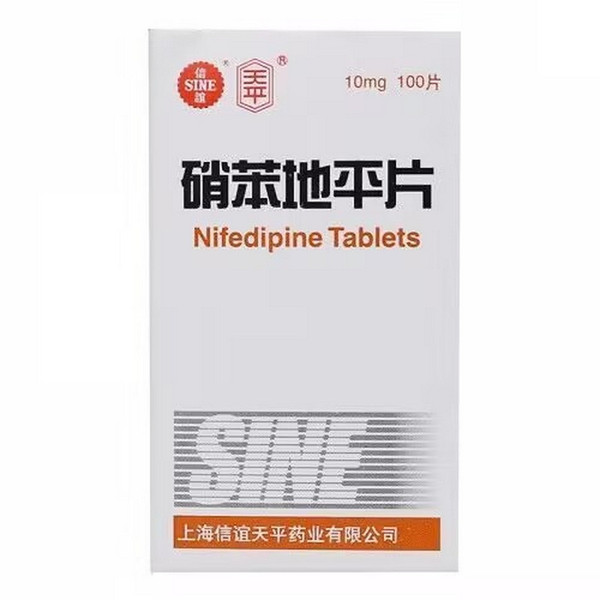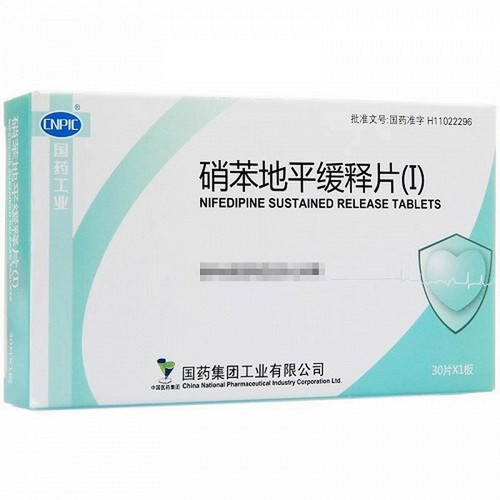Product Overview
[Drug name]
Generic name: Nifedipine sustained-release tablets
Trade name: Xinyi
English name: Nifedipine Tablets
Chinese Pinyin: Xiaobendiping Huanshi Pian
[Ingredients]
Nifedipine.
[Properties]
This product is a capsule with brown microparticles.
[Indications]
1. Hypertension (alone or in combination with other antihypertensive drugs). 2. Angina pectoris: especially variant angina pectoris.
[Usage and Dosage]
1. Swallow the whole tablet on an empty stomach. Do not chew or break it apart. 2. Start with a small dose. The initial dose is 20 mg/time, the maximum dose is 60 mg/time, once a day. The maximum daily dose does not exceed 120 mg. 3. The dose of nifedipine should be gradually adjusted according to the patient's tolerance and control of angina pectoris. Monitor the patient's blood pressure before increasing the dose. If the patient's symptoms are obvious, the dose adjustment period can be shortened according to the patient's response to the drug. 4. No "rebound" symptoms were observed when the drug was discontinued, but the dosage still needs to be gradually reduced and the patient's condition should be closely observed. 5. The dose of the ordinary preparation can be safely replaced by the dose of the sustained-release preparation. For example: the ordinary preparation 30mg/time, three times a day, can be replaced by the sustained-release preparation 90mg/time, once a day.
[Adverse Reactions]
1 Common adverse reactions include peripheral edema (proportional to the dose); headache, etc. 2 Adverse reactions with uncertain relationship to this product: dizziness; nausea; constipation; fatigue; facial flushing and heat sensation. 3 1%-3% adverse reactions: chest pain; leg pain; paresthesia; vertigo; rash; leg cramps; nosebleeds; rhinitis; impotence; frequent urination, etc. 4 1% adverse reactions: cellulitis; chills; facial edema; neck pain; pelvic pain; atrial fibrillation; bradycardia; cardiac arrest; premature beats; hypotension; palpitations; phlebitis; postural hypotension; tachycardia; anxiety; loss of libido; depression; insomnia; lethargy; pruritus; night sweats; abdominal pain; diarrhea; dry mouth; indigestion; esophagitis; bloating; gastrointestinal bleeding; vomiting; lymphadenopathy; gout; weight loss; arthralgia; arthritis; myalgia; dyspnea; cough; pharyngitis; blurred vision; amblyopia; conjunctivitis; diplopia; kidney stones, etc. 5 Rare adverse reactions: allergic hepatitis; alopecia; anemia; antinuclear antibody-positive arthritis; erythromelalgia; peeling. 6 Exfoliative dermatitis; fever; gingival hyperplasia; male breast development; leukopenia; mood swings; muscle pain; nervousness; purpura; tremor; sleep disorders; Stevens-Johnson syndrome; syncope; thrombocytopenia; toxic epidermal fusion necrosis; instant blindness at peak blood drug concentration; tremor; urticaria, etc.
[Contraindications]
It is contraindicated for patients who are allergic to nifedipine.
[Precautions]
1 Hypotension: Most patients only have mild hypotension after taking nifedipine, and some patients have severe hypotension symptoms. This reaction often occurs during the dose adjustment period or when the dose is increased, especially when used in combination with beta-blockers. Blood pressure needs to be monitored during this period, especially when other antihypertensive drugs are used in combination. 2 Peripheral edema: The patient's mild to moderate peripheral edema is proportional to the dose taken and is related to arterial dilation. Edema often occurs initially at the end of the lower limbs and can be treated with diuretics. For patients with congestive heart failure, it is necessary to distinguish whether the edema is caused by further deterioration of left ventricular function. 3 Interference in diagnosis: When using this product, alkaline phosphatase, creatine phosphokinase, lactate dehydrogenase, aspartate aminotransferase and alanine aminotransferase are occasionally increased. Generally, there are no clinical symptoms, but cholestasis and jaundice have been reported; platelet aggregation is reduced, bleeding time is prolonged; direct Coomb test is positive with/without hemolytic anemia. 4 Patients with liver and kidney dysfunction and those taking beta-blockers should use it with caution, and it is advisable to start with a small dose to prevent inducing or aggravating hypotension, increasing the incidence of angina pectoris, heart failure, and even myocardial infarction. When patients with chronic renal failure use this product, there is occasionally a reversible increase in blood urea nitrogen and creatinine, and the relationship with nifedipine is not clear.
[Medication for special populations]
Children's precautions: Children are prohibited.
Precautions during pregnancy and lactation: Precautions for pregnant women. Clinical studies in nursing mothers are not sufficient, and it is best not to breastfeed when taking this product.
Precautions for the elderly: This experiment has not been conducted and there are no reliable references.
【Drug Interactions】
1 When used in combination with nitrates, it can control angina attacks and has good tolerance. 2 When used in combination with beta-blockers, most patients have good tolerance and efficacy for this product, but some patients may induce and aggravate hypotension, heart failure and angina. 3 When used in combination with digitalis, it may increase the blood digoxin concentration, suggesting that the blood concentration of digoxin should be monitored when using this product for the first time, adjusting the dose or stopping this product. 4 When used in combination with drugs with high protein binding rates, such as dicoumarols, phenytoin sodium, quinidine, quinine, warfarin, etc., the free concentrations of these drugs often change. 5 When used in combination with cimetidine, the peak plasma concentration of this product increases, so pay attention to adjusting the dose. 6 When grapefruit juice is taken with this product, the Cmax and AUC of this product increase.
【Pharmacological Action】
Nifedipine is a dihydropyridine calcium antagonist that selectively inhibits the transmembrane transport of calcium ions into myocardial cells and smooth muscle cells, and inhibits the release of calcium ions from intracellular reservoirs without changing the plasma calcium ion concentration. Pharmacological Action This product can simultaneously relax the coronary arteries in the normal blood supply area and the ischemic area, antagonize spontaneous or ergonovine-induced coronary artery spasm, increase the delivery of myocardial oxygen to patients with coronary artery spasm, and relieve and prevent coronary artery spasm. It can also inhibit myocardial contraction, reduce myocardial metabolism, and reduce myocardial oxygen consumption. On the other hand, it can relax peripheral resistance vessels, reduce peripheral resistance, reduce systolic and diastolic blood pressure, and reduce cardiac afterload. This product can delay the sinus node function and atrioventricular conduction of isolated hearts; electrophysiological studies of whole animals and humans have not found that this product has the effect of delaying atrioventricular conduction, prolonging the recovery time of the sinus node, and slowing down the sinus node rate. Toxicological Action Carcinogenicity, Mutagenicity and Reproductive Toxicity No carcinogenicity. No mutagenicity. High doses can reduce the fertility of female mice; can cause teratogenesis; can cause miscarriage (increased drug absorption rate in fetal mice, increased fetal mortality, and decreased survival rate of newborn mice). Pregnant monkeys taking 2/3-2 times the maximum human dose can cause small placenta and chorionic dysgenesis; giving rats 3 times the maximum human dose can cause prolonged pregnancy.
[Storage] Shade and store in a sealed container.
[Specification] 20mg
[Packaging specification] 24 tablets/box
[Validity period] 36 months
[Implementation standard] National drug standard WS1-(X-058)-2004Z
[Approval number] National medicine standard H31022750
[Instruction manual revision date] June 21, 2010
[Manufacturer] Company name: Shanghai Xinyi Tianping Pharmaceutical Co., Ltd.







